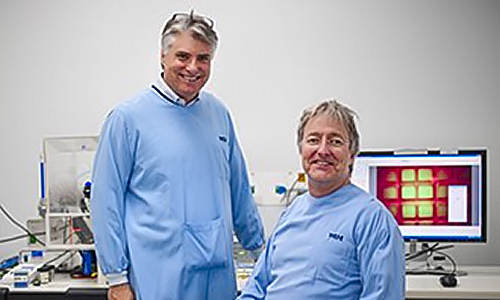Melbourne researchers have overturned a 40-year-old theory on when and how cells divide, showing that ‘parent’ cells program a cell division time for their offspring that is different from their own.
Professor Phil Hodgkin (L), Dr John Markham and colleagues from the institute have developed a new model of predicting how cells have divided over time.
Scientists from the Walter and Eliza Hall Institute have shown that both phases of the cell cycle contribute to the overall change in division time rather than one staying fixed in duration as previously thought. They have developed these findings into a new model that helps scientists predict how a population of cells has divided.
Their research could impact our understanding of cell replication, such as occurs during the immune response to infection or in cancer development and progression. The study was published in the journal Proceedings of the National Academy of Sciences.
Institute scientists Professor Phil Hodgkin, Dr Mark Dowling, Dr John Markham, Dr Andrey Kan and colleagues made the discovery while studying how immune cells called B and T cells divided over time. Using time-lapse microscopy, the research group followed individual cells, observing each phase of the cell cycle as the cell divided into two new ‘daughter’ cells and recording how long each phase took.
The cell cycle can be broken into two phases. In the first phase, cells grow in size and make the proteins required to copy their DNA. In the second stage, the DNA is copied and final preparations are made to split the cell in half in a final stage known as mitosis. Since 1973, scientists have predicted cell division using a model that captures the overall length of the cell cycle, but does not explain how long each phase may last.
Dr Markham, who completed the research while at National Information and Communication Technologies Australia (NICTA), said the study found the time taken for each stage of the cell division cycle varied from cell to cell. “The old model of cell cycle times didn’t fit our observations, so we developed a new model that more accurately predicts how a population of cells has divided,” Dr Markham said.
“Imagine the cell cycle as an elastic band, representing the time a cell takes to divide. Each phase of the cell cycle is in a fixed place on the elastic band, but the band itself can stretch or shrink, effectively elongating or shortening the time taken for each phase of the cycle.”
Professor Hodgkin said the study not only provided a better model for how cells divided, it also provided clues as to why there was variability in cell cycle times across a group of the same cell type. “The old model assumed the second phase of cell division took a fixed amount of time, with all the variability coming from the first phase,” he said. “It used a concept called ‘transition probability’ to predict how a population of cells may behave, but it couldn’t be applied individual cells.
“Our study revealed that when a cell divides, its two ‘daughter’ cells share the same division time as each other, but this time is different from their ‘parent’. From this we can conclude that cell division times are programmed by the parent cell when preparing to divide, but that time is not carried across generations. While we don’t yet understand exactly how it is set, this internal timing mechanism has replaced the external ‘transition probability’ used in the old model.”
Professor Hodgkin said although the study provided a better understanding of fundamental science, it would also have practical applications, for example in investigating how immune cells responded to infections. “Our model will allow researchers to take fewer, simpler measurements to complete the picture of how B cells and T cells have divided,” Professor Hodgkin said. “However more work is still needed to determine whether these mechanisms are the same in other types of cells in the body, such as cancer cells.”
Story Source:
The above story is based on materials provided by Walter and Eliza Hall Institute of Medical Research.





